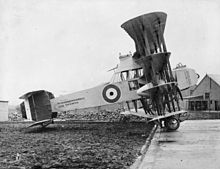Four-decker (airplane)
In aviation, a four-decker is an aircraft with four wings arranged one above the other . The design with four superimposed wings with ailerons on all surfaces gave these machines particularly great maneuverability because of the smaller wingspan and the associated lower moment of inertia . The four wings influenced each other even more strongly than on the already very manoeuvrable three-decker , so that the additional wing increased the air resistance and thus greatly reduced the flight performance , i.e. the maximum speed and range . During the First World War , this very rare type of construction was used for a short time, but was not able to establish itself mainly due to the disadvantage of speed, which is decisive for combat use.
The best known example is the British military aircraft Armstrong Whitworth FK10 from 1917, which was designed as a fighter and reconnaissance aircraft , but was inferior to British three- deckers such as the Sopwith Triplane despite its outstanding maneuverability. The flight performance was a little below that of the Sopwith 1½ Strutter .
Another four-decker was the British fighter prototype Pemberton Billing PB29E , from which the Supermarine Nighthawk (initially referred to as the Pemberton Billing PB31E Night Hawk ) was developed for use against high-flying zeppelins , but the latter never reached operational readiness due to its far inadequate flight performance.

